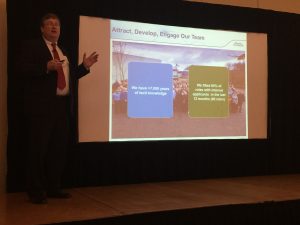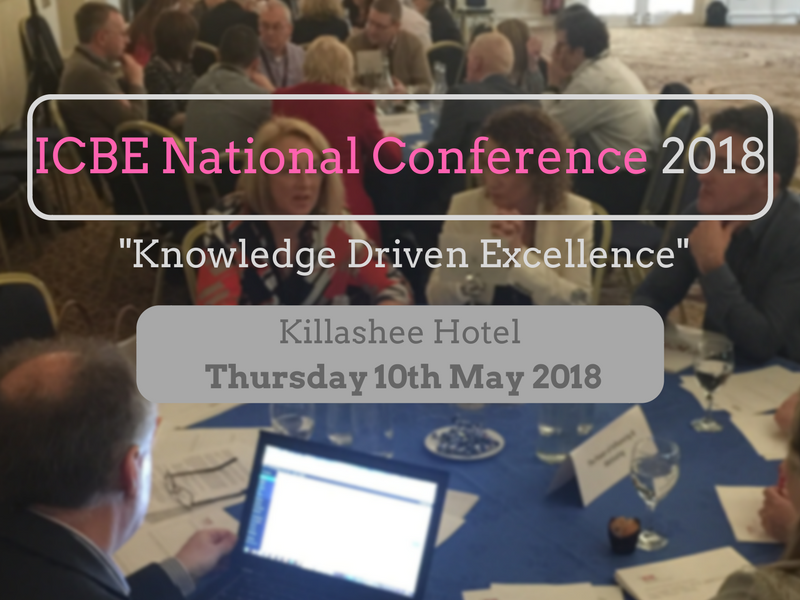 “During our Shingo Journey, Leaders Standard Work was a key enabler in allowing us to demonstrate and nurture the ideal behaviors required of the 4 dimensions of the Shingo Model: Cultural Enablers, Continuous Improvement, Enterprise Alignment and Results” said Sean Gayer – Site Director, Boston Scientific, Cork in his talk entitled ‘Leaders Standard Work’.
“During our Shingo Journey, Leaders Standard Work was a key enabler in allowing us to demonstrate and nurture the ideal behaviors required of the 4 dimensions of the Shingo Model: Cultural Enablers, Continuous Improvement, Enterprise Alignment and Results” said Sean Gayer – Site Director, Boston Scientific, Cork in his talk entitled ‘Leaders Standard Work’.
Leaders Standard Work (LSW) is a way that assesses and sustains the overall health of ALL systems. It includes a set of daily, weekly and monthly actions and behaviours that leaders apply to sustain a continuous improvement culture
Commenting on other methodologies Mr Gayer said “Lean is harder than is seems. Improvements gained through the use of lean tools can be hard to maintain as the force of habit is to go backwards.”

Mr Gayer then discussed the benefits of Leaders Standard Work which include;
Go See:. The power of leaders is presence, where leaders spend their time determines what is important to the organisation.
Engage People: By being a visible leader engagement increases.
Focus on the Process: By focusing on the process we drive further improvements and build the team’s problem solving capability through coaching.
According to Mr Gayer, the foundation to successful LSW is TRUST. A blame free culture where employees are comfortable highlighting problems and where leaders take note of these concerns, coach and support follow up.
For Leaders Standard Work to be of successful there has to be a frame work in place. This should include:
- Visual Controls so problems are visible
- An active Daily Accountability Process
- Robust Problem Solving/Continuous Improvement systems.
Mr Gayer added some final advice in accessing effectiveness “Your actions and behaviours as a leader is what make LSW successful. Not the tool you are using to track it. How do you know it is successful? It is what the team says about you as a leader, their willingness to get involved in running the business and shaping the future.”
Output form the Table discussion
There was some level of leader std. work in place in some of the organisations. There is general understanding of the concept around the table.
There was acknowledgement that this type of event is powerful way to capture and develop the network. Capturing and sharing information is key to learning. So this type of process is a nice addition.
Good conversation between all groups, great interactions and sharing of different views. Good pace to the conversation and engagement.
4 groups discussed the topic
Main Points captured
- Importance of presence of managers is key part of Leader Standard Work
- How does LSW account for manager styles and how can this be applied to different styles of manager
- Production Operator level have 100% defined by standard work and this changes in % as you go up the organisation
- It’s to drive a standard on what is key to the system
- As a senior leader your responsibility is around be seen, enable engagement ad recognition
- Education of the Leadership team and getting buy in is key
- What’ the “Why” – Needs to be understood
- Trying to find out what’s important vs. urgent.
- Prioritise appropriately
- Reflection on what working and not and using this to influence the future.
- Highlights problems and allows them to be corrected
- Keep it visible and keep it simple – Allows all people to engage
- What the training that is required –
- One system had the instructions integrated into the system
- Simplicity is key
- Send a designate if you can’t attend, system needs to be supported
- Management walking around is key
- Elimination of Email thru the Pulse of the business meeting –
- So easy to communicate a common message quickly
- Operator like the face to face engagement option that recognition walks enable.
- Quick and easy recognition is another key enabler to get engagement
- LSW is about engagement but it may start of as a mechanical system.
- Trust – is driven by focusing on the process and not the “who”
- Accountability back to the person who identified the item, to close it.
- What’s is meant by leader in “Leader Standard Work”, anyone
- On group –Senior Leadership Team and Middle Managers
- One group – Anyone who has a direct report
- There is some cross over in LSW and standard work of Individual.
Group 2
Shared the last group’s topics and there was alignment with their observations.
Main Point Captured
- Good understand of what is needed but How do we get there is unclear
- In the middle of rolling out our Tier boards
- Meeting Structure and agenda is driven by the board
- Some levels of checks in place
- Tier 2 meeting with Sup and Eng. team and manager working
- Dir. will comes in and observe
- No standard to what the dir. is looking at
- Most elements are present but its hit and miss – Looking to drive consistency
- Driven from the top is key to success.
- Lacking Structure – Meeting and systems are in place.
- Looking at LSW to remove waste and making meetings and systems more effective.
- It’s not a tick the box exercise or engagement
- Drives engagement
- Challenge – Making things visible, if you don’t stick to it then you are lost
- The system is flexible and can be changed to fit circumstances.
- Needs to be genuine – can’t be saying great job just at a certain time and not calling it out in normal day to day interactions.
- SME dedicated to support LSW to embed the system. They were tasked with driving engagement.
- This process created a scorecard on health check
- Focus on the process – Key to driving success – Not the person.
- Day in the Life exercise – people jumped into the role to see what was preventing people getting LSW done.
- Working from the position that people are trying to do the right thing to understand what is preventing them.
